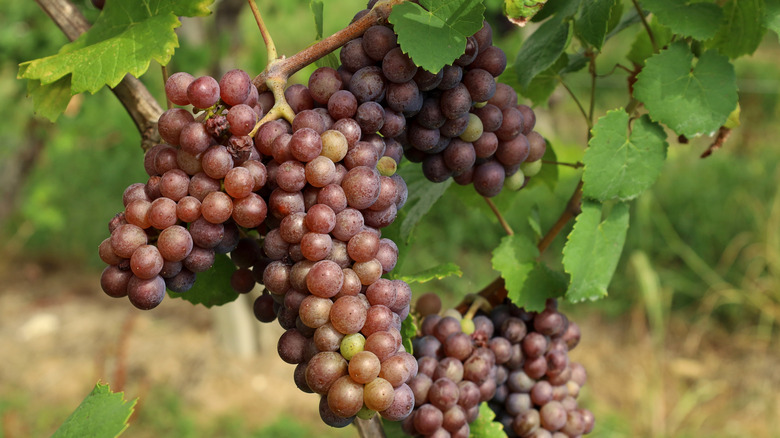Is There A Difference Between Pinot Gris And Pinot Grigio Wine?
A perpetual crowd-pleaser, pinot has been a popular pour for decades. But, while pinot noir is synonymous with light-bodied red and rosé wines and pinot blanc of refreshing whites, pinot gris is harder to fit neatly into a box. This is because pinot gris can also be referred to as pinot grigio. Much like primitivo and zinfandel or syrah and shiraz, the two pinots are one and the same. Aside from a difference in name, you might be surprised to learn that pinot gris and pinot grigio can have entirely different profiles.
A mutation of the red pinot noir grape varietal, VinePair explains that blue-tinged pinot gris grapes — originally called Tokay d'Alsace — can be traced back to the Middle Ages in Burgundy. The grapes made their way into Switzerland and eventually into northern Italy, where the name was translated to pinot grigio. But the diffusion doesn't end there. MasterClass explains that pinot gris was adopted in Germany (as grauburgunder), in addition to Austria and Hungary (as szürkebarát), before finding popularity abroad in the U.S., Australia, and New Zealand.
Even though the berries are significantly darker than most white grapes, Decanter explains that pinot gris / pinot grigio grapes often result in a dry, white wine that falls between a neutral Pinot Blanc and an aromatic Gewurztraminer — the key word being often. Naturally, flavor and intensity can vary between pinot gris and pinot grigio based on terroir and winemaking.
Differing origins and winemaking styles make for differing profiles
Although pinot gris grapes can be grown in various places, most winemakers will label their wines based on which style they more closely align, either as a French (Alsace) pinot gris or an Italian (Veneto, Friuli-Venezia Giulia, and Trentino-Alto Adige) pinot grigio. That said, where pinot gris tends to be medium to full-bodied with plump richness, Wine Spectator explains that pinot grigio is generally light-bodied and crisp.
Given that most pinot grigio is harvested early to preserve a high level of acidity, MasterClass explains that the wine boasts a freshness that recalls pear, apple, and stone fruit. In contrast, pinot gris offers lower acidity and higher sugar levels, resulting in spicy notes and honeyed nuances when left to ripen fully. Unsurprisingly, this level of complexity makes a pinot gris more adept for barrel-aging (via Usual Wines) and even cellaring compared to a pinot grigio.
However, it's important to remember that these generalizations aren't always accurate. For example, while pinot gris is usually dry, Wine Enthusiast explains that it can also be used to make late-harvest wines labeled vendanges tardives. Likewise, a seemingly simple pinot grigio can boast quite a bit of depth when left to macerate in a "ramato" style, shares Decanter – taste the difference for yourself, and prepare to be amazed!

